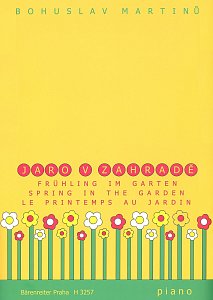MARTINU: Spring In The Garden - Four children's pieces for piano
| Publisher | Barenreiter |
| Genre: |
music for children, pupils and students
classical & sacret |
| Arrangement: | piano |
| Cast: | solo |
| Difficulty: | Intermediate |
| Format: | book |
| Series: | Czech composer |
Parameters
| Product code: | H3257 |
| Composer: | Martinů, Bohuslav |
| Author / Editor: | Březina, Aleš |
| No. of songs: | 4 |
| Pages: | 16 |
| Language: |
English
German French Czech |
| Size: | 23 x 31 cm |
| EAN: | 9790260102194 |
| ISMN: | 979-0-2601-0219-4 |
| Weight: | 106 g |
Songlist (4)
- Jaro v zahradě 1
- Jaro v zahradě 2
- Jaro v zahradě 3
- Jaro v zahradě 4
Product description
The set of four piano pieces for children titled Jaro v zahrade (Spring in the Garden), H. 125 by Bohuslav Martinu is here published in a new edition. The composer's autograph is missing today, and therefore the editor Ales Brezina (whose changes are indicated in the musical text with square brackets) limited himself to correcting several obvious errors. He has retained the fingering suggested by Vilém Kurz who prepared the first edition. Perhaps the most visible change from earlier editions is omission of the titles of individual pieces in the set, because it is very likely that they are not the invention of the composer but rather were added later by the publisher or someone else. The piano texture is simple and takes into consideration the instructive intention of the work, whose greatest attributes are its lyricism and playfulness. Preface by the editor is published in four languages (Cz./Eng./Ger./Fr.).
Bohuslav Martinů (1890-1959) was a Czech composer, violinist, pedagogue and music critic. His artistic development progressed from impressionism through neoclassicism, expressionism and jazz inspiration to a purely compositional style of his own. Stylistically, he is closest to the generation of neo-classicists such as Arthur Honegger, Béla Bartók and others.




